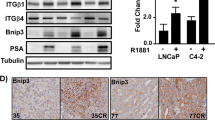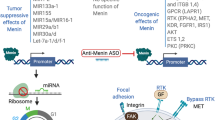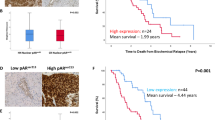Abstract
Cryoablation has emerged as a primary therapy to treat prostate cancer. Although effective, the assumption that freezing serves as a ubiquitous lethal stress is challenged by clinical experience and experimental evidence demonstrating time–temperature-related cell-death dependence. The age-related transformation from an androgen-sensitive (AS) to an androgen-insensitive (AI) phenotype is a major challenge in the management of prostate cancer. AI cells exhibit morphological changes and treatment resistance to many therapies. As this resistance has been linked with α6β4 integrin overexpression as a result of androgen receptor (AR) loss, we investigated whether α6β4 integrin expression, as a result AR loss, contributes to the reported increased freeze tolerance of AI prostate cancer. A series of studies using AS (LNCaP LP and PC-3 AR) and AI (LNCaP HP and PC-3) cell lines were designed to investigate the cellular mechanisms contributing to variations in freezing response. Investigation into α6β4 integrin expression revealed that AI cell lines overexpressed this protein, thereby altering morphological characteristics and increasing adhesion characteristics. Molecular investigations revealed a significant decrease in caspases-8, -9, and -3 levels in AI cells after freezing. Inhibition of α6β4 integrin resulted in increased caspase activity after freezing (similar to AS cells) and enhanced cell death. These data show that AI cells show an increase in post-freeze susceptibility after inhibition of α6β4 integrin function. Further understanding the role of androgen receptor-related α6β4 integrin expression in prostate cancer cells responses to freezing might lead to novel options for neo-adjunctive treatments targeting the AR signaling pathway.
This is a preview of subscription content, access via your institution
Access options
Subscribe to this journal
Receive 4 print issues and online access
$259.00 per year
only $64.75 per issue
Buy this article
- Purchase on Springer Link
- Instant access to full article PDF
Prices may be subject to local taxes which are calculated during checkout





Similar content being viewed by others
References
Jemal A, Siegel R, Ward E, Murray T, Xu J, Smigal C et al. Cancer statistics, 2006. CA Cancer J Clin 2006; 56: 106–130.
Kendirci M, Bejma J, Hellstrom WJ . Update on erectile dysfunction in prostate cancer patients. Curr Opin Urol 2006; 16: 186–195.
Baust JG, Gage AA, Clarke D, Baust JM, Van Buskirk R . Cryosurgery–a putative approach to molecular-based optimization. Cryobiology 2004; 48: 190–204.
Grubb 3rd RL, Vardi IY, Bhayani SB, Kibel AS . Minimally invasive approaches to localized prostate carcinoma. Hematol Oncol Clin North Am 2006; 20: 879–895.
Mouraviev V, Polascik TJ . Update on cryotherapy for prostate cancer in 2006. Curr Opin Urol 2006; 16: 152–156.
Babaian RJ, Donnelly B, Bahn D, Baust JG, Dineen M, Ellis D et al. Best practice statement on cryosurgery for the treatment of localized prostate cancer. J Urol 2008; 180: 1993–2004.
Cohen JK, Miller Jr RJ, Ahmed S, Lotz MJ, Baust J . Ten-year biochemical disease control for patients with prostate cancer treated with cryosurgery as primary therapy. Urology 2008; 71: 515–518.
Baust JG, Gage AA . Progress toward optimization of cryosurgery. Technol Cancer Res Treat 2004; 3: 95–101.
Gage AA, Baust JG . Cryosurgery for tumors—a clinical overview. Technol Cancer Res Treat 2004; 3: 187–199.
Onik GM, Cohen JK, Reyes GD, Rubinsky B, Chang Z, Baust J . Transrectal ultrasound-guided percutaneous radical cryosurgical ablation of the prostate. Cancer 1993; 72: 1291–1299.
Ahmed S, Lindsey B, Davies J . Salvage cryosurgery for locally recurrent prostate cancer following radiotherapy. Prostate Cancer Prostatic Dis 2005; 8: 31–35.
Bahn DK, Lee F, Badalament R, Kumar A, Greski J, Chernick M . Targeted cryoablation of the prostate: 7-year outcomes in the primary treatment of prostate cancer. Urology 2002; 60 (2 Suppl 1): 3–11.
Bahn DK, Lee F, Silverman P, Bahn E, Badalament R, Kumar A et al. Salvage cryosurgery for recurrent prostate cancer after radiation therapy: a seven-year follow-up. Clin Prostate Cancer 2003; 2: 111–114.
Chin JL, Touma N . Current status of salvage cryoablation for prostate cancer following radiation failure. Technol Cancer Res Treat 2005; 4: 211–216.
Katz AE, Rukstalis DB . Introduction. Recent scientific and technological advances have challenged the traditional treatment options for patients with localized prostate cancer. Urology 2002; 60 (2 Suppl 1): 1–2.
Long JP, Bahn D, Lee F, Shinohara K, Chinn DO, Macaluso Jr JN . Five-year retrospective, multi-institutional pooled analysis of cancer-related outcomes after cryosurgical ablation of the prostate. Urology 2001; 57: 518–523.
Wong WS, Chinn DO, Chinn M, Chinn J, Tom WL, Tom WL . Cryosurgery as a treatment for prostate carcinoma: results and complications. Cancer 1997; 79: 963–974.
Hellerstedt BA, Pienta KJ . The current state of hormonal therapy for prostate cancer. CA Cancer J Clin 2002; 52: 154–179.
Kish JA, Bukkapatnam R, Palazzo F . The treatment challenge of hormone-refractory prostate cancer. Cancer Control 2001; 8: 487–495.
Chen CD, Welsbie DS, Tran C, Baek SH, Chen R, Vessella R et al. Molecular determinants of resistance to antiandrogen therapy. Nat Med 2004; 10: 33–39.
Powell SM, Brooke GN, Whitaker HC, Reebye V, Gamble SC, Chotai D et al. Mechanisms of androgen receptor repression in prostate cancer. Biochem Soc Trans 2006; 34: 1124–1127.
Brakebusch C, Fassler R . The integrin-actin connection, an eternal love affair. EMBO J 2003; 22: 2324–2333.
Howe A, Aplin AE, Alahari SK, Juliano RL . Integrin signaling and cell growth control. Curr Opin Cell Biol 1998; 10: 220–231.
Calaluce R, Bearss DJ, Barrera J, Zhao Y, Han H, Beck SK et al. Laminin-5 beta3A expression in LNCaP human prostate carcinoma cells increases cell migration and tumorigenicity. Neoplasia 2004; 6: 468–479.
Wu C, Dedhar S . Integrin-linked kinase (ILK) and its interactors: a new paradigm for the coupling of extracellular matrix to actin cytoskeleton and signaling complexes. J Cell Biol 2001; 155: 505–510.
Mol AJ, Geldof AA, Meijer GA, van der Poel HG, van Moorselaar RJ . New experimental markers for early detection of high-risk prostate cancer: role of cell-cell adhesion and cell migration. J Cancer Res Clin Oncol 2007; 133: 687–695.
Rabinovitz I, Mercurio AM . The integrin alpha6beta4 functions in carcinoma cell migration on laminin-1 by mediating the formation and stabilization of actin-containing motility structures. J Cell Biol 1997; 139: 1873–1884.
Carloni V, Romanelli RG, Mercurio AM, Pinzani M, Laffi G, Cotrozzi G et al. Knockout of alpha6 beta1-integrin expression reverses the transformed phenotype of hepatocarcinoma cells. Gastroenterology 1998; 115: 433–442.
Grashoff C, Thievessen I, Lorenz K, Ussar S, Fassler R . Integrin-linked kinase: integrin′s mysterious partner. Curr Opin Cell Biol 2004; 16: 565–571.
Morgan M, Saba S, Gower W . Fibronectin influences cellular proliferation and apoptosis similarly in LNCaP and PC-3 prostate cancer cell lines. Urol Oncol 2000; 5: 155–159.
Chatterjee S, Brite KH, Matsumura A . Induction of apoptosis of integrin-expressing human prostate cancer cells by cyclic Arg-Gly-Asp peptides. Clin Cancer Res 2001; 7: 3006–3011.
Bonaccorsi L, Carloni V, Muratori M, Salvadori A, Giannini A, Carini M et al. Androgen receptor expression in prostate carcinoma cells suppresses alpha6beta4 integrin-mediated invasive phenotype. Endocrinology 2000; 141: 3172–3182.
Bonaccorsi L, Carloni V, Muratori M, Formigli L, Zecchi S, Forti G et al. EGF receptor (EGFR) signaling promoting invasion is disrupted in androgen-sensitive prostate cancer cells by an interaction between EGFR and androgen receptor (AR). Int J Cancer 2004; 112: 78–86.
Bonaccorsi L, Muratori M, Marchiani S, Forti G, Baldi E . The androgen receptor and prostate cancer invasion. Mol Cell Endocrinol 2006; 246: 157–162.
Evangelou A, Letarte M, Marks A, Brown TJ . Androgen modulation of adhesion and antiadhesion molecules in PC-3 prostate cancer cells expressing androgen receptor. Endocrinology 2002; 143: 3897–3904.
Davis TL, Rabinovitz I, Futscher BW, Schnolzer M, Burger F, Liu Y et al. Identification of a novel structural variant of the alpha 6 integrin. J Biol Chem 2001; 276: 26099–26106.
Jasavala R, Martinez H, Thumar J, Andaya A, Gingras AC, Eng JK et al. Identification of putative androgen receptor interaction protein modules: cytoskeleton and endosomes modulate androgen receptor signaling in prostate cancer cells. Mol Cell Proteomics 2007; 6: 252–271.
Nagakawa O, Akashi T, Hayakawa Y, Junicho A, Koizumi K, Fujiuchi Y et al. Differential expression of integrin subunits in DU-145/AR prostate cancer cells. Oncol Rep 2004; 12: 837–841.
Edlund M, Miyamoto T, Sikes RA, Ogle R, Laurie GW, Farach-Carson MC et al. Integrin expression and usage by prostate cancer cell lines on laminin substrata. Cell Growth Differ 2001; 12: 99–107.
Persad S, Attwell S, Gray V, Delcommenne M, Troussard A, Sanghera J et al. Inhibition of integrin-linked kinase (ILK) suppresses activation of protein kinase B/Akt and induces cell cycle arrest and apoptosis of PTEN-mutant prostate cancer cells. Proc Natl Acad Sci USA 2000; 97: 3207–3212.
Wu C . ILK interactions. J Cell Sci 2001; 114: 2549–2550.
Wu D, Thakore CU, Wescott GG, McCubrey JA, Terrian DM . Integrin signaling links protein kinase Cepsilon to the protein kinase B/Akt survival pathway in recurrent prostate cancer cells. Oncogene 2004; 23: 8659–8672.
Koenigsmann MP, Koenigsmann M, Notter M, Neuloh M, Mucke C, Thiel E et al. Adhesion molecules on peripheral blood-derived CD34+ cells: effects of cryopreservation and short-term ex vivo incubation with serum and cytokines. Bone Marrow Transplant 1998; 22: 1077–1085.
Sakai T, Li S, Docheva D, Grashoff C, Sakai K, Kostka G et al. Integrin-linked kinase (ILK) is required for polarizing the epiblast, cell adhesion, and controlling actin accumulation. Genes Dev 2003; 17: 926–940.
Liu BL, McGrath J . Response of cytoskeleton of murine osteoblast cultures to two-step freezing. Acta Biochim Biophys Sin (Shanghai) 2005; 37: 814–818.
Schnier JB, Nishi K, Gumerlock PH, Gorin FA, Bradbury EM . Glycogen synthesis correlates with androgen-dependent growth arrest in prostate cancer. BMC Urol 2005; 5: 6.
Foty RA, Steinberg MS . Cadherin-mediated cell-cell adhesion and tissue segregation in relation to malignancy. Int J Dev Biol 2004; 48: 397–409.
Klossner DP, Baust JM, VanBuskirk RG, Gage AA, Baust JG . Cryoablative response of prostate cancer cells is influenced by androgen receptor expression. BJU Int 2008; 101: 1310–1316.
Onik G . Image-guided prostate cryosurgery: state of the art. Cancer Control 2001; 8: 522–531.
Bhandari MS, Petrylak DP, Hussain M . Clinical trials in metastatic prostate cancer--has there been real progress in the past decade? Eur J Cancer 2005; 41: 941–953.
Davies G, Jiang WG, Mason MD . Cell-cell adhesion molecules and signaling intermediates and their role in the invasive potential of prostate cancer cells. J Urol 2000; 163: 985–992.
Pawar SC, Dougherty S, Pennington ME, Demetriou MC, Stea BD, Dorr RT et al. alpha6 integrin cleavage: sensitizing human prostate cancer to ionizing radiation. Int J Radiat Biol 2007; 83: 761–767.
Jennbacken K, Gustavsson H, Welen K, Vallbo C, Damber JE . Prostate cancer progression into androgen independency is associated with alterations in cell adhesion and invasivity. Prostate 2006; 66: 1631–1640.
Klossner DP, Robilotto AT, Clarke DM, VanBuskirk RG, Baust JM, Gage AA et al. Cryosurgical technique: assessment of the fundamental variables using human prostate cancer model systems. Cryobiology 2007; 55: 189–199.
Werner ME, Chen F, Moyano JV, Yehiely F, Jones JC, Cryns VL . Caspase proteolysis of the integrin beta4 subunit disrupts hemidesmosome assembly, promotes apoptosis, and inhibits cell migration. J Biol Chem 2007; 282: 5560–5569.
Stupack DG, Puente XS, Boutsaboualoy S, Storgard CM, Cheresh DA . Apoptosis of adherent cells by recruitment of caspase-8 to unligated integrins. J Cell Biol 2001; 155: 459–470.
DeRoock IB, Pennington ME, Sroka TC, Lam KS, Bowden GT, Bair EL et al. Synthetic peptides inhibit adhesion of human tumor cells to extracellular matrix proteins. Cancer Res 2001; 61: 3308–3313.
Clarke DM, Baust JM, Van Buskirk RG, Baust JG . Chemo-cryo combination therapy: an adjunctive model for the treatment of prostate cancer. Cryobiology 2001; 42: 274–285.
Clarke DM, Baust JM, Van Buskirk RG, Baust JG . Addition of anticancer agents enhances freezing-induced prostate cancer cell death: implications of mitochondrial involvement. Cryobiology 2004; 49: 45–61.
Clarke DM, Robilotto AT, VanBuskirk RG, Baust JG, Gage AA, Baust JM . Targeted induction of apoptosis via TRAIL and cryoablation: a novel strategy for the treatment of prostate cancer. Prostate Cancer Prostatic Dis 2007; 10: 175–184.
Le Pivert P, Haddad RS, Aller A, Titus K, Doulat J, Renard M et al. Ultrasound guided combined cryoablation and microencapsulated 5-Fluorouracil inhibits growth of human prostate tumors in xenogenic mouse model assessed by luminescence imaging. Technol Cancer Res Treat 2004; 3: 135–142.
Martinez-Montiel MP, Munoz-Yague MT . Biologic therapies for chronic inflammatory bowel disease. Rev Esp Enferm Dig 2006; 98: 265–291.
Acknowledgements
This study was funded in part by Galil Medical USA Inc. (Plymouth Meeting, PA), Cell Preservation Services Inc. (Owego, NY), and The National Institutes of Health.
Author information
Authors and Affiliations
Corresponding author
Ethics declarations
Competing interests
The authors declare no conflict of interest.
Rights and permissions
About this article
Cite this article
Baust, J., Klossner, D., VanBuskirk, R. et al. Integrin involvement in freeze resistance of androgen-insensitive prostate cancer. Prostate Cancer Prostatic Dis 13, 151–161 (2010). https://doi.org/10.1038/pcan.2009.59
Received:
Revised:
Accepted:
Published:
Issue Date:
DOI: https://doi.org/10.1038/pcan.2009.59
Keywords
This article is cited by
-
Re-purposing cryoablation: a combinatorial ‘therapy’ for the destruction of tissue
Prostate Cancer and Prostatic Diseases (2015)



